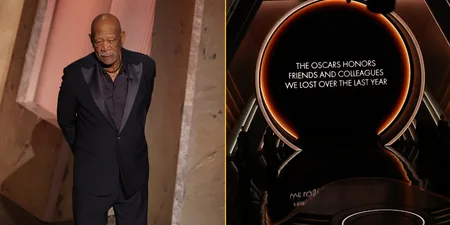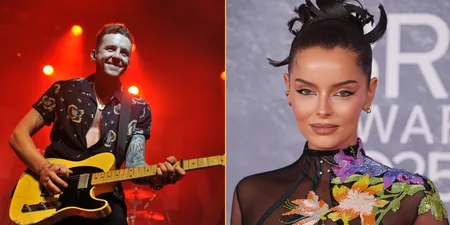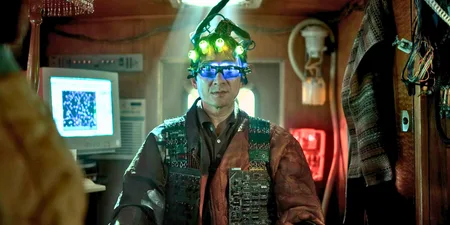On first glance, you could easily be watching CBeebies
Two puppets, a fuzzy duck and a Bert-and-Ernie-knock off, are being taught the food groups by song. All seems fine.
And then you realise that something is kind of, well, off. White sauce, cream and aspic do not belong in the same group. Eating “fancy food” does not make your teeth go grey.
And then there’s a smash cut to an operating theatre, where the duck is ripped open, to reveal very real-looking, decidedly non-puppet guts.
Welcome to the world of Don’t Hug Me I’m Scared.
Originally debuting on YouTube in 2011, over the course of six three-to-eight minute episodes DHMIS has amassed a cult following – one that loves to obsess over the show’s hidden meanings and cosplay as the characters. And after racking up over 200 million views, a half-hour pilot for a full television series is set to debut at the 2019 Sundance Film Festival, six years after the first instalment was also shown at the festival.
If you’ve never seen it, it is probably best to just set aside 30 minutes and fry your brain by watching all six episodes back to back. But for the uninitiated, DHMIS is a melding of a Jim Henson puppet show and the nightmare visions of David lynch – with a bit of Tim & Eric Awesome Show Great Job thrown in for good measure.
Each short starts with three anthropomorphic puppets (the aforementioned Yellow Guy and Duck Guy, along with string covered giant Red Guy), being aggressively interrupted by an anthropomorphic object forcing them to learn nonsensical lesson about time or computers or love. Then slowly but surely, things descend into a surreal fever dream of existentialism, paranoia, and raw meat.
The show is the brainchild of former art students Becky Sloan and Joe Pelling, who met while studying at Kingston University. “It may have been as simple as we just wanted to make some puppets,” says Pelling, on the original genesis.
“It was all done in a backwards way – we just started making the puppets,” continues Sloan. “The Yellow Guy was the first puppet I ever made, which is why he looks so mental.”
“We knew we wanted to do something about breaking down the world into simple lessons, but it just failed every time. And we knew we wanted it to be a musical. [So] puppets just seemed like the right tool to use for that.”
The first episode was made over a weekend, in under a railway arch posing as a studio. An army of friends were roped in to help, and they worked through the night. Sloan describes the shoot as “mental” and “intense”, and it all culminated with a 2am visit from the fire brigade after nearly setting the place ablaze.
“We had these big shoot lights, and they were way too close to the metal,” says Sloan. “We just smelt this burning and we realised it was melting the roof. When the fire brigade came we were wafting the fire alarm with this tablecloth covered in blood. We had just been shooting this lung covered in blood.”
“They came into a room with loads of meat, and loads of people in a weird kids show set,” adds Pelling, laughing.
They put the finished film on YouTube, almost as an afterthought. “There wasn’t really any plan, we didn’t submit it to any festivals or anything,” says Sloan. “We just put it online. And then it went viral.”
It very quickly became a cult hit, having been viewed over 53 million times since it was first uploaded. “It seemed to trickle along, and suddenly a lot of people were really into it,” says Pelling. “We definitely didn’t anticipate that.”
The success brought plenty of interest from production companies wanting to develop Don’t Hug Me I’m Scared into something bigger. They got an invite to Sundance. They made music videos for Tame Impala and Unknown Mortal Orchestra. They worked with Tash Demetriou, Tim Key and Adam Buxton on a PSA for St Johns Ambulance.
But they kept Don’t Hug Me I’m Scared theirs. The second episode was commissioned by Channel 4’s Random Acts strand, but after that they raised over £100,000 on Kickstarter to produce the rest of episodes with production company Blink Industries – meaning they retained control.
“Sometimes you have people who get it, and sometimes who don’t,” says Joe on the interest they received. “Sometimes we were speaking to people who had different ideas about we would develop it, and we were not massively into them”.
“It was all kind of ‘How does you thing slot into our thing?’” chips in Baker Terry, a former classmate of Sloan and Pelling who came on board as co-writer. “We didn’t want to enter into that, and end up with some unsatisfying thing nine years later.”
“We would have had to change it drastically and it would have been a different thing,” continues Pelling. “It could have been way better!”
When asked about influences, Pelling says “I suppose [we like] the stuff that you would expect us to like, we do like”. All three mention David Lynch, almost in unison. The Simpsons, David Cronenberg, and Tim & Eric also come up. Fittingly, they also profess a love for other weird internet videos, including found footage collective Everything Is Terrible, and David O’Reilly’s MS Paint nightmare-fuel Octocat Adventure.
What really gets all three of them really animated though is talking about the bizarre old puppet shows they’ve discovered via YouTube compilations and internet crate digging. Sloan starts reeling them off. ”Watch With Mother, Fingerbobs… There’s loads of really weird ones that you find.”
“The Hugga Bunch is a sort of early 80s, straight to video movie,” continues Pelling. “It’s a bit Alice In Wonderland or Wizard of Oz, but it is mental because the main girl is so strange.”
“She’s meant to be 8 years old, but looks about 40,” adds Sloan, before excitedly going on to describe her favourite deep cut.
“And then there’s Candy and Andy. It only made it as far as being a hardback book, but it was made by Gerry Anderson, who made Thunderbirds. It’s this really weird book with these photos of mannequin dolls set ups, of this brother and sister, but they’ve got panda bears as parents. I think that’s been quite a big influence.”
You can look Candy and Andy up yourself, and it is genuinely terrifying.

Of course, Don’t Hug Me I’m Scared is far from the first thing to use the basic jumping off point of ‘Sesame Street, but violent and for adults’. Peter Jackson made Meet The Feebles in the 1980s, and stage musical Avenue Q has been a hit around the world. Even just last year Jim Henson’s son Brian teamed Melissa McCarthy with some foul-mouthed muppets in The Happytime Murders, albeit to complete critical and commercial failure.
None of those feel at all similar to DHMIS though. Instead of shock value, it is filled with existential dread. “There’s no swearing or bad language in it, it’s more kind of mood,” says Terry. “It’s more insidious than just swearing puppets that jizz everywhere and vomit.”
“We’re not trying to make people disgusted. We wouldn’t want to become too brutal. Sometimes what fun is trying to [provoke the audience] without doing the obvious.”
Pelling: “The reason people kept coming back to was that this story was interesting, and the characters were something they bought into. If it was just that at the two-minute mark of every episode, you dumped a bucket of guts to the ground, people would stop coming back.”
“Without sounding too up our own arses,” concludes Terry, “it’s more a visual arts take on weird puppets, than a parody.”
To illustrate his point, take for instance the previously mentioned fifth episode. It starts with The Red Guy suspiciously absent. The Yellow Guy and The Duck Guy are then accosted by singing food stuffs, and it is vaguely implied that The Red Guy may have been eaten. An ominous red phone rings, interrupting the song, and we get flashes to a hospital ward, maybe suggesting this is actually all just a television show being observed by a hallucinating patient. But then at one point, the camera is knocked over, and we see the it is all just the studio, and the legs of The Red Guy are clearly visible.
What does it all mean? No explanation is given, but the lack of answers has only made fans more devoted. They go through every frame with a fine tooth comb. YouTube explainer videos have racked up almost as many views as the originals. But the creators are in no rush to spell it all out.
“I think it is quite boring, this impulse to explain everything,” says Pelling. “I hope that people take all those [explainer videos] with a pinch of salt. Don’t just believe all of them – they all seem to contradict themselves anyway.”
“It’s not fun for anyone,” agrees Sloan. “I don’t think it would be fun for them either, if we just went ‘This is a metaphor for this’”.
That obsession from the fanbase has fed back into the production though. “You put attention to detail into [it], knowing that there is going to be an audience that will appreciate it,” says Pelling.
Sloan: “It’s really fun playing with the interactive-ness of it.”
“We hid a phone number in one of the episodes, in the credits on this phone box. We set up a SIM card on a phone we could answer. We thought no one would find it.”
“Within, like, a minute it was ringing. People would record themselves talking to us, and upload that. And it just became this loop.”
“The people who called up couldn’t believe it wasn’t just a recording,” continues Pelling. “We’d respond to them in real time, and they’d wonder how we were doing this! We are really talking to you! And then they’d hang up in panic. It kept going for weeks.”
It’s just a pilot that’s set to be shown at Sundance – they envision it being a series of six-to-ten half-hour episodes, though if, when, and where that’ll happen still remains to be seen.
But regardless of the future, Pelling says this is the right moment for it to happen: “We’ve pushed the show forward and grown it into something bigger. It was nice to wrap up [the first] incarnation of it, all on YouTube.”
“Now we have the opportunity to make a full TV show. We proved ourselves with the existing short and now were not being asked to change it, just expand it.”
“We try not to think about where it will end up,” says Sloan, “and make what we want to make.”











































